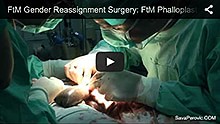Complications & Corrections of FtM Phalloplasty
Revisions of Total Phalloplasty & GRS
About 7% of patients experience some type of complication with Total Phalloplasty surgery Stage One, all of which are naturally occurring. In other words, even though the surgery goes perfectly, a challenge to perfect healing can arise.
If minor surgical corrections is needed, it can be done when the patient returns to Belgrade for the next stage. Before allowing anyone anywhere to intervene in your surgical results, FIRST discuss the situation with Dr Djinovic. If urgent or an emergency, pick up the phone and call him.
Some patients discover they have flown to Belgrade and back several times for the cost of a minor intervention done in their own country by relatively clueless local doctors. Got a problem or a concern — discuss it with Dr Djinovic FIRST before doing anything.

Our FtM procedures have a 100% success rate — eventually. That means that some penises fail to survive, particularly in patients who have a previous history of flap failure done elsewhere by other surgeons. Many have lingering systemic infections and/or a suppressed immune system and are basically unhealthy.
Some patients have pre-existing conditions they hide from the surgeon, fearing he would refuse to do the surgery. This has also caused flap failure.
Some patients have unusually bad vascularity or below average size blood vessels or suffered damage to key veins or arteries during previous surgery. These factors can also threaten the vitality and survival of a neophallus.
Regardless of the cause and reason for a setback, Dr Djinovic is committed to a good final surgical result that solves the gender identity disorder and gives the patient good quality of life with close to normal genitalia.
That usually requires that the remaining musculocutaneous latissimus dorsi (MLD) tissue on the other side of the patient's body be used. This is the meaning of total success eventually.
One Australian patient suffered partial flap necrosis in mid-2008 due to a unique vascular drainage problem of his graft tissue.
He got corrective surgery in mid-2009 and subsequently wrote to the doctors saying:
I am very, very happy and very impressed with the result and appearance of my new penis. Your team is obviously gifted with this kind of surgery ... I am very appreciative of both Professor Perovic and Dr Djinovic for giving me the opportunity to redo the phalloplasty again, especially with waiving all of the fees associated with the recent surgery.
Dr Djinovic always does such revision or corrective surgery without fee.
Dr Djinovic is now able to identify this rare condition immediately upon removing the MLD flap. If this particular situation is encountered:
- the blood circulatory system of the flap is surgically enhanced;
- the flap is returned to it's location at the donor site for six weeks or longer for improvement of its vascularity (flap autonomization); and the
- surgery is postponed to a later date when the patient's body has improved the blood supply within the donor tissue and recovered from the initial surgery.
Organ removal tends to be uneventful and without complications at all. Only the extremely complex and challenging Total Phalloplasty Stage One still has single digit percentage of problems.
Some patients discover during recovery from the neophallus creation surgery that it causes unpleasant irritation to the clitoris. During Stage One surgery, the clitoris is first mobilized, then anchored. In subsequent stages of surgery, it can be moved anywhere the patient prefers within a surprisingly large anatomical area.
For that reason, repositioning the clitoris is not a problem. Just ask the surgeon during Stage 2 or 3.
Scar revision is considered a standard but rarely mentioned component of Total Phalloplasty. Although there are three stages, it is considered one procedure and whatever gets a good aesthetic and functional final result is considered the responsibility of the surgeons and included in the overall package.
Dr Djinovic completely redoes MLD donor site scars that have been stretched during healing, sometimes an inch or more (several centimeters) wide.
It is considered unimportant whether the ugly scars were the result of insufficient donor site massage preparation or any other reason. Good aesthetics dictate that scars be pencil line thin, unobtrusive and unnoticeable as much as possible, even though they are under the patient's arm and not seen under most conditions.
During Stage Three, the tissue of the patient's chest area is greatly relaxed and softened. Scar tissue is removed and the healthy, normal skin stitched back together with numerous small stitches using very small filament for the best possible healed appearance.
Patients who super-sized their penis and discover in the real world that giant penises are not in great demand by women, contrary to urban myth, can have them surgical downsized and shortened (within limits).
Dr Djinovic does a lot of plastic surgery. If you would benefit from a tummy tuck or liposuction while in Belgrade for Stage 2 or 3, discuss it with the doctor.
next: Post-op Care
